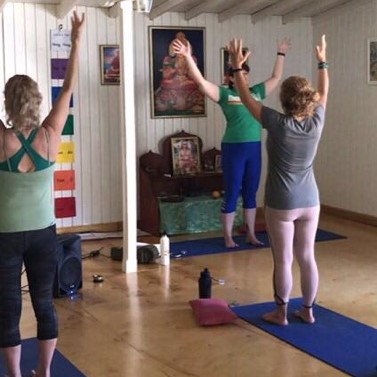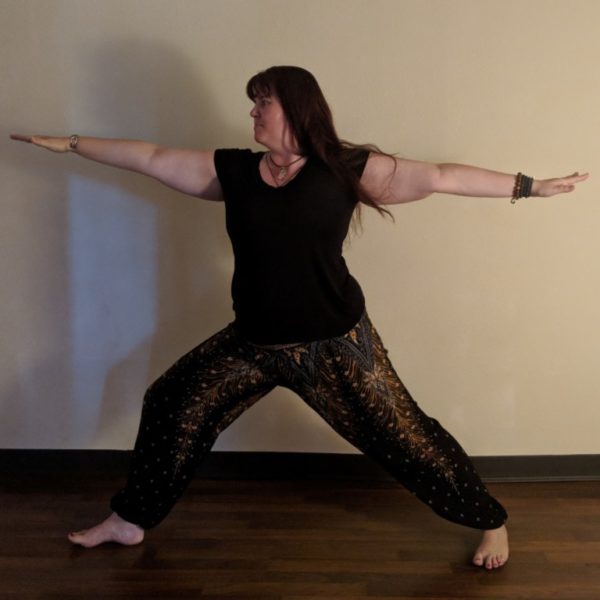Āsana is so much more than a yoga posture. My teacher, Rama Jyoti Vernon, teaches that the word āsana means “to be and to breathe and to become one with the eternal cosmic vibration.” It is sacred geometry and brings our bodies into alignment with higher vibrations. When held with a relaxation of effort and meditation upon the infinite, we achieve mastery of the posture (according to the Yoga Sūtras of Patanjali, 2:47-48). When this mastery occurs, the opposites no longer exert force on our minds, bodies, and energy. This is when we can truly be and breathe with our true nature, and experience union with the Divine and our sacred sense of self.
While this may sound beautiful and eloquent, how often do we experience this fullness? Sometimes we are just rolling through the poses to get the job done, while the mind takes inventory of our lives. Our yoga practice can become an exercise and lose the profound and blessed aspects that help us reconnect to our sacred sense of self every day.
The practice of LifeForce Yoga goes far beyond posture for posture’s sake. We practice to release the constrictions that keep us from realizing our true nature as wholeness in each moment. To do this, we must hold the mind in the present moment. If you have ever had issues with stress, anxiety, depression, and/or trauma, you know how easy it is to do your yoga practice while thinking about other things. This is why we add mantras and other sounds to our practice.
The sounds that we use can be soothing or energizing. For instance, “ma-ha-ra” helps us to connect to the energy of calm strength when we are moving through a sun salutation. This works even better when we invite an image for calm strength. Or, we can use the soothing sounds “sha-ma-ya,” to help us connect to peaceful energy. The sounds are nothing more than syllables that are linked together with an image/visualization to foster a specific mindset. This is the practice of bhavana, the cultivation of an attitude that brings us closer to the eternal cosmic vibration. The Yoga Sūtras of Patanjali teach us vitarka badhane pratipaksha bhavanam, “where there are constrictive thoughts, feelings, or emotions, cultivate freeing thoughts, feelings, or emotions” (2:33).
We also use the chakra mantras in postures. The mantras help to energize our connection to the chakra and the element represented by the chakra. We might want to ground, energize, open, or focus our energy with both the posture and the chakra. These mantras are beautiful in promoting such an intention within our practice. Here are a few examples:
Mountain Pose – Tadasana
Stand with the feet underneath the hips. Wiggle the feet and the toes to start establishing a connection to the feet. Lift and spread the toes, waking up the arches. Make sure that your knees are soft and not locked. Allow the thigh muscles (quadriceps) to engage lightly, while you draw the lower abdomen in just enough to wake it up. With the exhale, invite the spine to lengthen up while relaxing the shoulders down the back. You may wish to keep the arms at the side or lengthen them above the head.

Imagine yourself as though you are as strong, grounded, and present as the mountain. To this add the repetition of the root chakra mantra, lam (emphasizing the “L” sound and pronouncing the “am” as “um”). Do this four times. You may even feel the sound vibrating down to the feet.
This helps to increase a sense of grounding, that you are here and present. This is good for working with stress and anxiety as the mind is often on a worry journey. The root chakra is all about a sense of security and needs being met, which makes this practice fantastic for trauma and PTSD. When used for the depressed mood, this can energize, especially when using the arms overhead.
Warrior II Pose – Virabhadrasana
From your mountain pose, step the right foot back three to five feet. The hips open towards the side. To accomplish this safely for the right knee, make sure that the right foot is angled at about 60 degrees (no need to get out a protractor). The left knee bends so that the knee is directly over the ankle. The left knee may tip internally, so engage your left outer hip to draw the knee in line with the foot. Keep the torso aligned to center, neither leaning towards the left leg, nor the right. Take a deep breath in and on the exhale lift the arms out to the side.

Imagine that you are strong, self-assured, and connected to your internal sense of power. Add the repetition of the solar plexus mantra, ram (emphasizing the “R” sound and pronouncing the “am” as “um”). For a calmer sense of strength and courage, use one repetition per exhale 10 times. To awaken your self-esteem and self-worth, try repeating the sound 10 times per exhale three times with strength and force. Don’t be afraid to really get loud with this, you are breaking up the constrictions that block your self-esteem and self-worth. You are worth it!
This is such a beautiful practice for depressed moods and PTSD as it connects with energy and revs it up, especially when repeating the mantra 10 times per exhale with an image of courage or strength. The slower more meditative repetition is good for more anxious states as it won’t energize too much yet connects you to your self-esteem.
We will be exploring many more postures with sounds during the LifeForce Yoga Āsana to Manage Your Mood workshop coming up at Kripalu, July 5th – 7th. Register now to reserve your space!